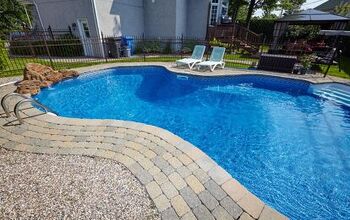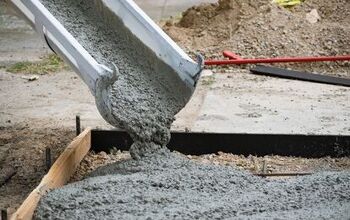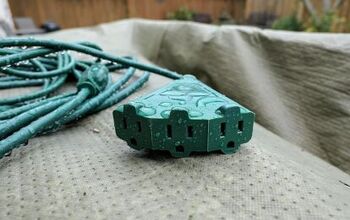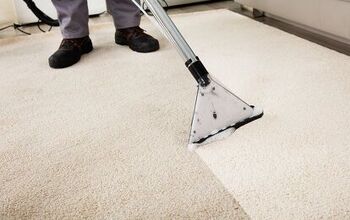Can You Sand Concrete? (Find Out Now!)

Let’s face it. In its natural form, concrete is not the most attractive material, but it is very durable. Interior designers have found ways to transform concrete to create a modern aesthetic. Finished concrete is now being used in kitchens, bathrooms, and other rooms in a home. Concrete is finished with a combination of sanding, tinting, and sealing.
Yes, you can sand concrete. For large jobs, use an orbital grinder. Use a sanding block for smaller areas. Use 40 to 60 grit sandpaper. If there are flaws in the concrete, use 80 to 120 grit sandpaper in those areas. Use 200 to 400 grit sandpaper to finish the surface. Wipe off any dust, and apply a concrete sealer.
Let’s take a look at how to sand concrete for various applications in the home.
Do You Need Concrete, Brick, or Stone Pros?
Get free, zero-commitment quotes from pro contractors near you.

What is Concrete?
Concrete is a soft material that is made when cement and an aggregate material, such as rocks, gravel, and sand, are mixed with water. The water activates the cement that acts like a glue for the aggregate materials. Concrete stands up to daily use, as well as the elements and chemicals. Sealed concrete is also ideal for kitchens and bathrooms because it is resistant to bacteria, mold, and other microorganisms.
Why Sand Concrete?
Concrete is sanded to give it a smooth surface and remove imperfections. It also prepares the material for painting and sealing.
How Long to Wait Before Sanding Concrete
Concrete needs to be completely set before you start sanding and finishing. Drying takes up to 10 days. The best approach is to wait. If you sand the concrete too soon, you’ll end up with an even rougher finish and a mess.
What to Use to Sand Concrete
The easiest way to sand large areas of concrete is with an orbital grinder and sand paper. Smaller areas and tight spaces need to be sanded by hand using a sanding block. Angle grinders are also good for sanding cement, but you should have some experience with the tool. Angle grinders require a greater level of control than orbital grinders.
Concrete needs to be sanded in stages. First, start with 40 to 60 grit sandpaper to remove most of the rough surface. If there are flaws or seams in the concrete, use 80 to 120 grit sandpaper. Finish the surface with a 200 to 400 grit sandpaper.
How to Sand Concrete
The most common uses for concrete are garage floors, walls, countertops, and patios.
Concrete Garage Floors
Concrete is the perfect material for garage floors. It absorbs spills, stands up to the weight of vehicles, and can take a beating. You don’t need to finish concrete in a garage for it to be durable. Sanding and sealing a garage floor make it easier to clean and seals against water and stains.
Use an orbital floor sander with a dust bag. The machine works with any type of sandpaper, and the dust bag saves time for cleaning up the work space. Fill in cracks and holes in the concrete with epoxy or a patching slurry. Make the first pass with a 30 to 60 grit sandpaper, then use 80 to 120 grit. For the final pass, use a 1,500-grit sandpaper.
Concrete Walls
Use a handheld orbital sander and sanding block for concrete walls. Because you do the work by hand, save time by using diamond sandpaper. Concrete walls should be fairly smooth, so you can start with a 40 to 60 sandpaper, and finish with a 200 to 400 sandpaper.
Concrete Countertops
Countertops that are made with concrete are either cast on-site or pre-cast and brought to your home. Some pre-cast concrete countertops are sanded and sealed before installation.
Use an orbital hand sander and 200 grit sandpaper. If you expose holes in the concrete when you are sanding, fill them with a slurry. Let the slurry set for a few hours, and sand them by hand.
Concrete Patios
Depending on the size of your patio, use an orbital floor sander or orbital hand sander. Start with a 200-grit diamond disc. Make a few passes over any uneven areas. Switch to a 300-grit diamond disc, and use an 800-grit diamond disc to finish the job. Rinse the concrete, and let it dry for 48 hours. Apply a concrete sealer.
How to Finish Sanded Concrete
Whether you use concrete outdoors or inside your home, it needs to be sealed. Use a penetrating sealer on driveways, garage floors, and patios. Epoxy sealers and polyurethane sealers are best for interior walls and countertops.
How to Sand a Concrete Patch
After you apply a slurry to patch a hole or crack in concrete, the texture may not match the original concrete. Use an orbital hand sander or sanding block. Start with 180-grit diamond sandpaper, and make passes with finer grits until the patch blends with the original concrete. Apply a sealant to the patch.
Related Questions
How do I repair a crack in concrete?
Make a slurry of cement and water. Fill in the crack, and remove any excess from the edges to even out the surface with the concrete slab.
How do I refinish concrete floors?
Fill in cracks and holes with a slurry. Apply a fresh coat of concrete stain or paint. You don’t need to strip concrete floors.
How much do concrete countertops cost?
Expect to pay $30 to $90 per square foot for concrete countertops. Labor costs $30 to $90 per hour. The installer may pre-fabricate the countertops, or pour concrete into molds onsite.
Do You Need Concrete, Brick, or Stone Pros?
Get free, zero-commitment quotes from pro contractors near you.

Summary
You can sand concrete. In fact, it is a best practice. From an aesthetic standpoint, it gives the concrete a finished loo. From a practical standpoint, it prepares the concrete for sealing.
Fill cracks and holes with a slurry of cement and water. Let it set for about 48 hours before sanding.
Use an orbital floor sander for patios, interior floors, and garage floors. Use a handheld orbital sander or sanding blocks for small areas and corners. You can also use an angle grinder to sand concrete. These tools are more powerful than orbital sanders, so exercise caution. If you work too quickly, you may gouge the concrete or remove too much. Use diamond sandpaper rather than normal sandpaper. It saves you time. Normal sandpaper works on concrete, but the work takes longer compared to using diamond sandpaper. You also use more materials, so it is well worth investing in diamond sandpaper.
Work in stages, and complete full passes before changing to a finer grit of sandpaper. Start with a 40 to 60 diamond sandpaper. Next, use an 80 to 120-grit diamond sandpaper. Finish with a 200- to 400-grit diamond sandpaper. If you want an even smoother finish, make a pass with a 1,500-grit diamond sandpaper.
Once you smooth out the surface of the concrete, it’s time to apply a sealant. Concrete patios and garage floors should be sealed with a penetrating sealer. Use an epoxy sealer or polyurethane sealer for interior walls and countertops. Apply two coats.
If you need to sand a concrete patch, use a handheld orbital sander or sanding block. Be sure to blend the outline of the patch with the original concrete. Gaps around a concrete patch are ideal places for water to penetrate and crack the concrete. Start with a lower-grit sandpaper, then use finer grits until the texture matches the original concrete. Seal the patch.

Jennifer L. Eggerton loves being hands-on, whether it's with a home DIY project, making repairs, re-decorating a room, or keeping life organized. She enjoys helping people by sharing her knowledge, insights, and experiences, as well as her lessons learned. In addition to her work as a writer, Jennifer is a Jeep® overlander, self-published author, and nature photographer who loves being outdoors.
More by Jennifer Eggerton



























